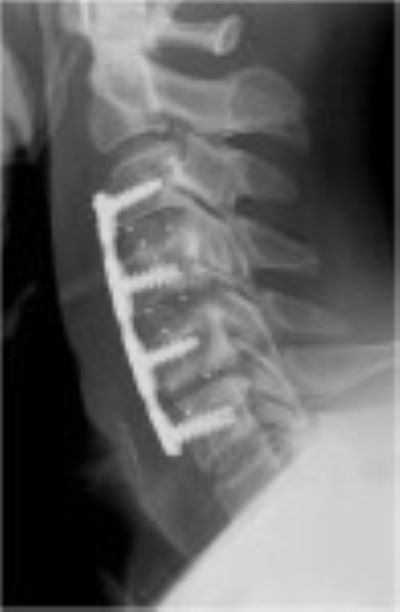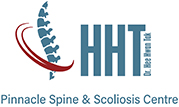This article describes the treatments for neck pain caused by degenerative (wear and tear) changes in the cervical spine.
Types of Neck Pain Treatment Options
Spinal Injections (Percutaneous Nerve Root Block, Facet Joint Block)
Spinal injections can be effective in alleviating pain in many degenerative conditions of the neck, and they can help speed up the recovery process.
The spinal injections are performed under local anaesthesia or light sedation. This procedure involves the patient lying on a special operating table which allows x-ray images to be taken of the spine. A fine needle will be inserted into the target area of interest to administer medications to the nerves and/or spinal joints.
Percutaneous Disc Decompression (Nucleoplasty)
In situations where the neck pain problem is due to a bulging disc irritating the nerves, percutaneous decompression of the disc may help alleviate the symptoms. The procedure, Nucleoplasty, aims to reduce the pressure on the nerves by using radiofrequency to cause a small volume reduction in the disc.
The patient will be gently sedated for the procedure, and again, this is performed with the help of CT (computed tomography) images taken on the affected spine. There will be a need to wear a soft neck collar for 4 weeks.
Anterior Discectomy and Fusion for Slipped Disc

Anterior cervical discectomy and fusion (Figure 1) is an operation performed on the front of the neck to relieve pressure on one or more nerve roots, or on the spinal cord. The term is derived from the words anterior (front), cervical (neck), and fusion (joining the vertebrae with a bone graft).
Anterior discectomy and fusion of the cervical spine are performed from the front of the neck. It was first described in the 1950s and is one of the more common spinal operations performed nowadays. The aim is to relieve the nerve(s) and/or spinal cord from compression, thereby allowing improvement of the environment for the nerve(s) and/or spinal cord to recover.
By relieving the compression, the fresh blood supply will allow delivery of nutrients as well as excretion of waste products of the nervous structures.
Fusion is commonly performed using a bone graft either from the patient’s bone or other sources. The objective is to maintain the space for the nerve(s) in the spinal column and stabilizing the affected segment of the spine.
During the surgery, the muscles of the neck will be dissected in between to get to the cervical spine. The windpipe and food channel will be gently retracted away to allow access to the surgical area.
The offending disc is correctly identified by x-ray imaging, and it is removed with the aid of an operating microscope.
At the end of the decompression, the nerve(s) and/or spinal cord are ascertained to be free from obstruction under the view of the microscope.
The second part of the operation is fusion (mentioned earlier) and stabilization with a titanium plate and screws placed in front of the affected spinal segment. The use of the titanium plate allows more immediate stability to be attained, and thus the patient does not have to wear an external collar for a prolonged period post-surgery.
Sometimes, the bony spurs pressing on the spinal cord may be located behind the vertebral body, and the surgery recommended will not only involve removing the discs, but also the vertebral body (anterior cervical corpectomy).
Artificial Disc Replacement

Neck surgery to replace a deteriorated disc with an artificial disc is a good option for some people. In general, if one is under 60 years old and the problem is due to a single disc of the neck, the person may be a suitable candidate for cervical disc replacement surgery. (Figure 2).
The surgery will involve general anaesthesia with the patient lying face up. Using x-ray images in real-time, the deteriorated disc will be removed from the front thoroughly so that the nerves are free, subsequently, an artificial disc is inserted into its original disc space.
This device is made from a combination of metal (either titanium or cobalt/chromium) and plastic. Depending on the situation, the patient will most likely need to wear a soft neck collar for several weeks.
Posterior Decompression and Stabilization
Sometimes, the spine surgeon may recommend operating from behind the neck (posterior). This is usually an indication that the patient has multiple levels of nerve and spinal cord compression.
The objective of performing posterior surgery is to increase the space available for the nerves and spinal cord. This can be done via laminectomy, whereby the bones (lamina) covering the spinal cord are removed.

Sometimes, the surgeon may also elect to stabilize the levels decompressed by placing titanium screws (Figure 3) at the back of the neck (fusion).

Laminoplasty (Figure 4) is another alternative to laminectomy. It is also recommended when there is evidence of narrowing of the spinal canal at many levels.
One prerequisite of performing this surgery is that the spine must not be crooked or in kyphosis, otherwise, the nerve compression will remain after surgery. This operation is performed from the back of the neck, after positioning the patient in the prone (face-down) position.
The procedure, in simplicity, creates more space for the spinal cord by creating and opening a trap door in the laminae of the spine. The difference with laminectomy is that the laminae or bones at the back of the neck are preserved instead of removed. Hence reducing the need for fusion.
Nowadays, there are newer methods of securing the opened laminae via mini plates and screws. They do not span across the joints of the neck, thus preserving the mobility of the neck.
Cervical foraminotomy is an operation to enlarge the space where a spinal nerve root exits the cervical spinal canal to relieve the symptoms of a “pinched nerve”. This procedure is often done when the spine surgeon is performing a laminectomy or laminoplasty.
If performed as an isolated procedure, it can be done in a minimally invasive fashion.
Adjunct A/Professor Hee Hwan Tak is an experienced spine surgeon who specializes in the treatment of degenerative conditions of the neck.
Consult Dr Hee for a comprehensive assessment and suitable neck pain treatment plan. Call us at +65 67370680 to make an appointment.
